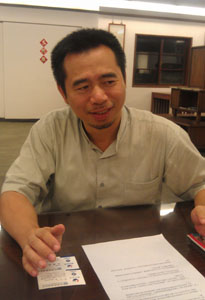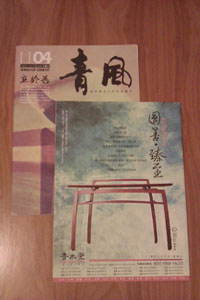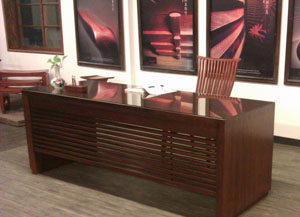Yung Shing Launches Brand to Cope Amid Competitive Market
Maker insists on only solid wood furniture despite changing technologies
2012/03/01 | By Michelle HsuWoody Chic, the brand Yung Shing Furniture Co. first introduced 12 years ago, was a turning point of the five-decade old furniture company established in 1958, which has had to adapt to changes along with the growth of Taiwan's furniture industry over the past half century.

“Branding is a strategy that Yung Shing adopts to identify its market position,” said the president William Jiang. Like many second-generation entrepreneurs in Taiwan, Jiang took the helm of a company older than himself at a time when diligence and hard work—the two major drivers of Taiwan's economic miracle during the 1970-80s—were still important but no longer enough to maintain steady growth in the changing international market, where tough competition forced Jiang to realize operations had to be adjusted just to survive and sharpen edges.
Yung Shing, to cope with worsening labor shortage in Taiwan, relocated production lines abroad around 20 years ago; while launching the Woody Chic brand first to target the Greater China area motivated the maker to extend operations to China at
an accelerated pace. Its business coverage in China spreads over 20 major cities, expanding along with the growing popularity of Woody Chic. The maker even publishes the quarterly “Wind of Orient” to keep Woody Chic members, fans informed of how oriental culture can shape their lifestyle.
In Taiwan, Yung Shing has transformed its half-century factory into an iconic tourism factory in southern Taiwan, with a 5-meter jumbo chair in front of the gate as landmark to direct visitors coming off the freeway into Tainan City.
Spread over some 6,610 square meters, the Yung Shing Tourism Factory has a furniture museum, an outdoor drift wood crafting area, as well as other facilities to hold cultural, social or academic activities, which promote themes of art, philosophy, or lifestyle complementary to the spirit of Woody Chic, which interprets modern, oriental ways through solid wood furniture.
All Natural
Despite evolving over the years to create a refreshed image of both the company and products, Yung Shing has been loyal to one principle for over five decades—to make furniture with only solid wood. Refusing to compromise as do makers of veneered fiberboard products, Yung Shing remains synonymous with furnishings made of fully natural woods.
Advocates of all wood furniture say that lumber remains alive even after being felled and made into a chair or table. Though hard, wood keeps its cellular structure after being processed, able to act like a sponge to emit or extract moisture from the ambiance. As such wood can change according to the season and weather, with ambient conditions able to warp lumber or furniture. Fans of wooden furniture find such characteristics attractive, along with the varieties of wood grain, texture and color; while some say the affinity between natural wood and users can't be duplicated with artificial materials.
Yung Shing used to adopt high quality woods native to Taiwan but has switched to imports from neighboring countries. “Huali,” a rosewood species, is a favorite the company uses for solid wood furniture, and is highly praised for quality texture, sweet fragrance, having a translucent shimmer with attractive abstract grains.
With color turning from reddish-brown to golden-yellow with time and exposure to light, huali is often dubbed “huang-huali” to reflect its yellowish tone. But Yung Shing typically uses reddish-brown huali in its products.

Relentless Mission
Yung Shing is also content to carry on the rich cultural content in its line of solid wood furniture, which is made with woodworking techniques passed down through the generations. In some ways, the maker has a relentless mission, to craft solid wood furniture of classical beauty that interprets cultural values in a modern way.
Despite the reality of business, Yung Shing chooses to focus on Chinese furniture even though the company started its wooden furniture business with orders from the American army stationed in Taiwan during the Korean War in the 1960s, then reached its heyday with exports of British-styled furniture in the 1980s.
Perhaps being facetious, Jiang said a cultural barrier exists for the firm to make furniture for foreigners, referring to it as “cultural landmine.” Implying that Chinese suppliers inherently can't perfect making western furnishings due to the cultural gap, Jiang's rationale is analogous to how some Chinese view the weakness in books on Chinese culture by so-called China expert.

Part of the reason for Yung Shing's success is the maker's grasp of the art of the mortise-and-tenon jointing technique unique in Chinese furniture and architecture. Credit also goes to Yung Shing's chief designer Lu Yuan-hua, whose skills have helped the company win many furniture design awards, creating a line of Woody Chic products that is appealing and marketable.




